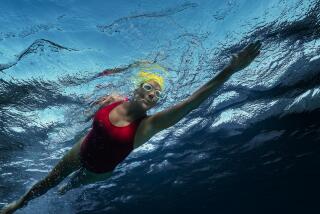AMERICA’S CUP : America 3 Changes Italians’ Tune : America’s Cup: U.S. boat takes a 2-1 lead over Il Moro di Venezia.
- Share via
SAN DIEGO — The Italians have always brought style, if not speed, to the America’s Cup. Each morning, tenor Luciano Pavarotti sends Il Moro di Venezia off to sea with his recording of the aria “Nessun Dorma” from Puccini’s opera “Turandot.”
It’s time for the Italians to change the music. Turandot has a happy ending, but Il Moro will not unless it starts doing more sailing than singing, benches Pavarotti and has skipper Paul Cayard roll up his sleeves and get down and dirty. The Italians aren’t going to catch America 3 without making it a street fight.
That became clear Tuesday. They let the Cup defenders get out of range and thumb their noses at them for 20 miles. America 3 won by 1 minute 58 seconds--about a third of a mile--to go ahead, 2-1, in the best-of-seven final match.
The next race will be Thursday.
“I think we’ll be looking at sailing a little differently on Thursday,” Cayard said.
Cayard is a protege of the late Tom Blackaller, who was a brawler on the race course and probably wouldn’t approve of Cayard’s sailing off to chase wind shifts like rainbows, rather than slugging it out--especially with an opponent who prefers to dance and jab from long range.
Dave Dellenbaugh, America 3’s starting helmsman, mixed it up in the prestart sparring just enough to move into position behind and to leeward of Il Moro two minutes before the gun, securing the left side he thought would be best.
“Nice job, David,” skipper-owner Bill Koch said.
Cayard, looking over his left shoulder, liked what he saw and was happy to go right--until a few minutes later.
After the boats split in opposite directions at the start, America 3 sailed into a 10-degree wind shift from the left. When that happens, the boat closest to the new wind direction gets a shortcut to the mark.
Helmsman Buddy Melges grabbed the gain, tacked right to loosely cover Il Moro “and that was basically the race,” Dellenbaugh said.
When the boats finally converged near the end of the leg, America 3 crossed five lengths in front, rounded the mark 47 seconds ahead and had only to sail conservatively thereafter, always staying between Il Moro and the next mark.
It was as boring and inevitable as Sunday’s three-second victory by Il Moro was exciting and suspenseful, but all three races have had one thing in common: The boat that gets in front stays in front. There hasn’t been a lead change yet.
Dellenbaugh said in all three starts the two boats held divided opinions on which side of the course was better. That’s amazing, considering the offshore weather buoys and other sophisticated technology they both use to forecast what the wind will do.
Cayard might as well have stuck a wet finger in the air.
“When we come in every day, the forecast is all ready for the next few days. (It is) updated at 7 a.m. the next day and is continuously updated up till the start,” he said.
“As the weatherman works by himself through the night and the early morning with the buoys, we augment that by having helicopters and support boats out there, and even our tuneup boat sails up near the windward mark. We have many sources of information that give us a final forecast for the race.
“We basically just drew the wrong conclusion. In the morning (the wind) was 300 (degrees, or northwest) when we were tuning up, and it was working its way left, and we thought the wall of how far left it would go would be 270 (degrees, due west). And that’s about what we had in the starting sequence. We wanted to start to the right of them because of that.”
Cayard said he soon knew that was a mistake, but being so far to the right and so far away from America 3 exaggerated the effect of the shift.
“I decided on the wrong side, and then I invested heavily,” Cayard said, “like buying into the stock market in October of ’87. It was Black Tuesday.
“Even if we wanted to start to the right of them, it’s better to start close to them and still have the right side. It’s playing too much into their hands and being a little too soft on them. When the boats are apart, it seems to be pretty comfortable for them. A drag race seems to be made to order for them.”
Some experts believed Cayard should have tacked back toward America 3 to mix it up as soon as he realized his error.
But Koch said in Sunday’s infighting, “we gained on every tack. We found . . . we think . . . we hope we can down-speed tack better than they do. I think they just realized they would lose if they tried that with us.”
With a comfortable lead and steady winds of 10 to 12 knots, Koch not only steered the three crosswind legs but stayed on the helm during the last two legs to guide his boat across the finish line.
His only problems were getting conked on the head again, this time by the boom before the start, and having to swerve around the ESPN “Scuba-Cam” diver at the fourth mark.
“It does seem that whenever he gets conked we win,” Dellenbaugh noted.
The outcome reinforced Koch’s favorite theme.
“Boat speed is a science,” he likes to say. “Sailing is an art. The thing about this is combining the science with the art.”
He didn’t mention singing.


